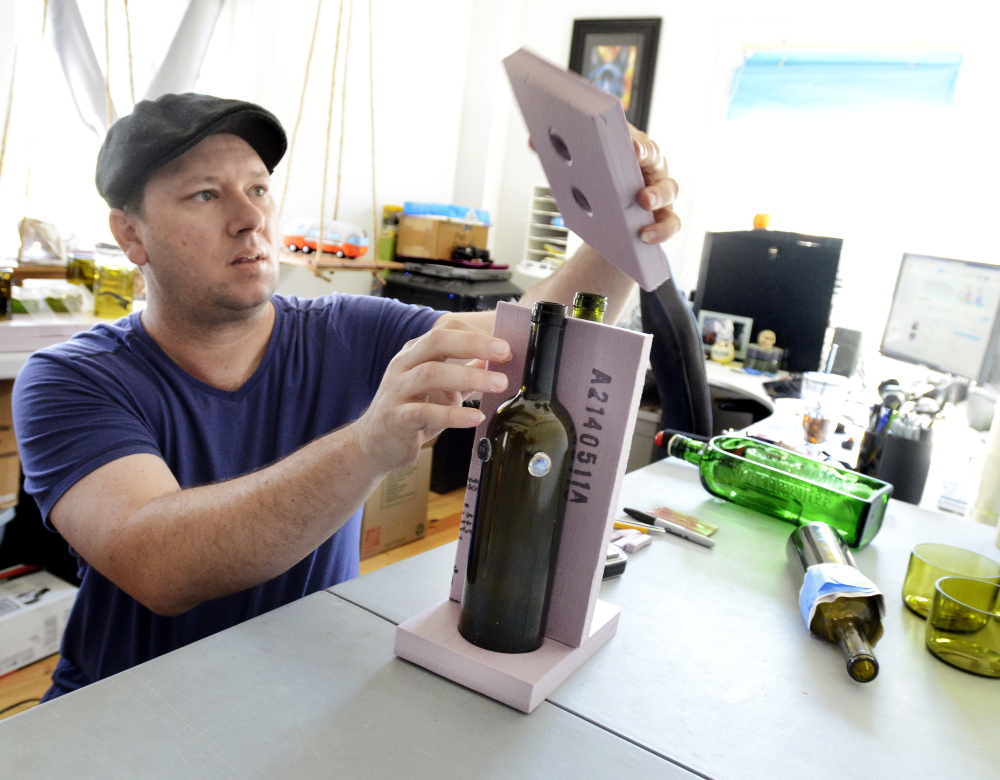Soon after Matt Staudenmaier and Grace Foley started their custom glass products business, they were dismayed to learn that many of their mail-order customers were receiving packages filled with broken shards.
The North Waterboro couple, who opened Conversation Glass in 2012, found that standard packing materials such as paper, peanuts and bubble wrap weren’t adequate to protect the company’s glass candle holders, service trays and other products made from empty wine, beer and liquor bottles.
“Since our business is online, pretty much everything we do is shipped,” Staudenmaier said. “One of the first orders we shipped, out of eight glasses, one or two of them were broken.”
The couple began asking customers to send pictures of the packages and their broken contents, hoping to conduct a forensic analysis of what went wrong.
They tried doubling and tripling the padding to the point that the packages became huge, but it still did not solve the problem. All it did was make them more expensive to ship, he said.
The breakage problem threatened to shatter their newly formed business like a wine glass hitting the floor. Staudenmaier and Foley realized they would have to get creative to save the company.
“We had to make a decision,” Staudenmaier said. “We had to figure something out.”
In an act of desperation, he went to Home Depot and started wandering up and down the aisles, hoping he might stumble upon a solution.
Finally, at the far corner of the store, all the way in the back, Staudenmaier found what he had been searching for.
“As I walked past the insulation section, I noticed large sheets of rigid pink foam about an inch think,” he said. “I thought that if I could cut circles of the right size for the glasses that the foam would have both the rigidity to reinforce the boxes and enough of a soft hold to protect the glass.”
Staudenmaier bought a sheet and started experimenting with ways to use it as a packing material. He and Foley packed some products in it and purposely dropped the packages to see if the glass held together.
“We’ve had all kinds of fun throwing packages around,” Staudenmaier said.
Through a process of trial and error, they discovered that cutting out holes in the insulation with a Dremel rotary tool and placing the glass products in those holes protected the contents of each package even when shaken or dropped.
“I’ve learned to leave some space between glasses and a good gap around the outside edge towards the box to allow for some bumps without hitting the glass,” Staudenmaier said.
But the couple didn’t stop there. They also experimented with packages of different sizes and weights to find the optimal choice for minimum breakage. They shipped packages via different carriers to see which one did the best job of delivering them intact.
It turned out that packages no heavier than 15 pounds and no larger than 16 x 16 x 12 inches fared the best, Staudenmaier said.
“We don’t really know why, but those are the magic numbers,” he said.
And the safest carrier with which to ship? The good old U.S. Postal Service, Staudenmaier said.
Thanks to the couple’s perseverance and creative thinking, the breakage problem is now a thing of the past.
“The only package we’ve lost is one that got run over by a truck,” he said.
Send questions/comments to the editors.




Comments are no longer available on this story